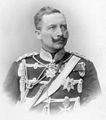Year of the Three Emperors
The year 1888 has gone down in German history as the year of the three emperors.
Emperor William I, who died in Berlin on 9 March, was succeeded by his son Frederick William, who had throat cancer, as Emperor Frederick III, who died in Potsdam on 15 June after a reign of 99 days. He was followed on the same day by his eldest son Frederick William, who ascended the throne as Emperor William II, German Emperor and King of Prussia. Within only four months, the German Empire was thus ruled by three rulers from directly successive generations.
· 
William I
1871-1888
· 
Frederick III
1888
· 
Wilhelm II
1888-1918
Numismatics
In the Three Emperors Year, only one coin denomination was minted, each with the image of one of the three emperors reigning in 1888. The 20-mark gold coin was produced at the mint in Berlin (A) with the following total mintage figures:
- William I (Jaeger 246): 533,854 copies,
- Frederick III. (Jaeger 248): 5,363,501 copies and
- Wilhelm II (Jaeger 250): 755,512 copies.
The set consisting of these three coins is coveted in collector circles and has a value of approx. 1,500 euros in the mint condition. In relevant mint houses it is offered for an average of about 2,300 euros.
Other coin values were issued in 1888 for only two of the three emperors: The 2-mark and 5-mark silver coins for Frederick III and William II, the 10-mark gold coin for William I and Frederick III.
Trivia
- In connection with the Three Emperors' Year, the saying arose in the vernacular: "Wilhelm I was the aged emperor, Frederick III the wise (or "quiet") emperor and Wilhelm II the travelling emperor.". This was a reference to Wilhelm I's advanced age of almost 91 and to Frederick III's muteness, caused by cancer of the larynx, which occurred shortly before his accession to the throne.
- The following saying can help to remember the year of three emperors: "One and three times eight: Three emperors in power".
- In antiquity there was a Four Emperors' Year in 69 AD, a Second Four Emperors' Year in 193 AD, and a Six Emperors' Year in 238 AD. In the former, four potential successors fought over the rule of the Roman Empire after Nero's death. Vespasian prevailed and founded the dynasty of the Flavians.
- The year 1888 was humorously called the Dreibrezeljahr because of the shape of the last three digits.
Questions and Answers
Q: What is the Year of the Three Emperors?
A: The Year of the Three Emperors, or the Year of the Three Kaisers, refers to the year 1888 during the German Empire in German history.
Q: Why is the Year of the Three Emperors important?
A: The Year of the Three Emperors is important because two German Emperors, or Kaisers, died. This meant that there were three emperors in a year.
Q: Who were the three emperors who ruled Germany during the Year of the Three Emperors?
A: The three emperors who ruled Germany during the Year of the Three Emperors were Wilhelm I, Frederick III and Wilhelm II.
Q: What is the mnemonic used in Germany to remember the Year of the Three Emperors?
A: The mnemonic “drei Achten, drei Kaiser” (English: "three eights, three emperors") is still used today in Germany to remember which year it was.
Q: What does the mnemonic "drei Achten, drei Kaiser" mean?
A: The mnemonic "drei Achten, drei Kaiser" translates to "three eights, three emperors" in English.
Q: In which country did the Year of the Three Emperors take place?
A: The Year of the Three Emperors took place in Germany during the German Empire.
Q: When did the Year of the Three Emperors occur?
A: The Year of the Three Emperors occurred in 1888.
Search within the encyclopedia